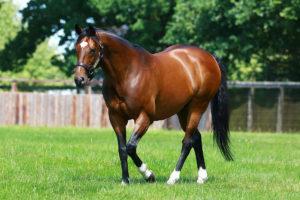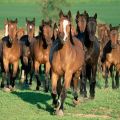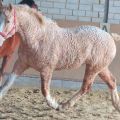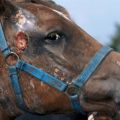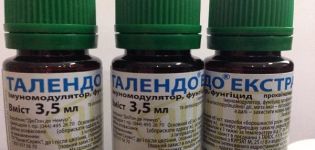Description of leptospirosis in horses, treatment and instructions for use of the vaccine
Leptospirosis infection refers to natural focal diseases and often affects both agricultural and domestic animals. At the first signs of leptospirosis in horses, it is necessary to separate healthy individuals from sick ones. Quarantine is introduced, isolated patients are treated. The release of bacteria from the body can last for years (depending on the form of the disease). Therefore, healthy horses must be vaccinated.
Description of the disease
One of the acute infectious diseases is leptospirosis (the causative agent is the bacterium Leptospira). Stagnant bodies of water, rivers, lakes, moist soil are suitable breeding grounds for bacteria. Leptospira are not resistant to disinfectants. Recovered and sick horses act as a source of leptospirosis Variants of distribution - contact, through feed, water. The incubation period lasts from 2-5 to 12-20 days. The characteristic of the infection is that the liver, kidneys, muscles, capillaries are affected, intoxication, fever are manifested.
Danger to horses
Leptospirosis affects animals in all regions. The infection proceeds in a severe form, in a neglected state there is a need for resuscitation. The consequences of the onset and spread of leptospirosis:
- significant weight loss in animals (17-28%);
- slower growth of foals;
- loss of efficiency by horses.
A severe illness often leads to the death of the animal. The likelihood of abortion and loss of reproductive function also increases.
Causes and symptoms
Damage to the skin, mucous membranes of the body, contaminated feed, bathing horses in infected water are the main ways for bacteria to enter the body. There are no clinical signs at the stage of the incubation period.

In the following days, the following stages of the disease can be distinguished:
- leptospiremia - characterized by the active reproduction of bacteria that accumulate in the adrenal glands, liver, spleen. Symptoms: body temperature rises sharply, thirst appears, signs of anorexia, hyperemia of the mucous membranes of the nasopharynx;
- toxic period - characterized by damage to blood cells, parenchymal organs caused by endotoxins (due to the defeat of bacteria by antibodies). External and internal bleeding in horses is accompanied by vomiting of blood, prolonged bloody diarrhea.
Leptospirosis is also manifested by a sharp dehydration of the equine body, stomatitis (ulcerative and necrotic), acute renal failure are observed. Sometimes the disease is subacute (the clinic manifests itself more slowly, and the symptoms are less pronounced). The main dangers of the subacute form are a mortality rate of 30-50% and a transition to a chronic disease.
Diagnosis and treatment of leptospirosis
Upon visual examination of the sick individual, the following symptoms are observed: icteric color of the mucous membranes, mild colic, rapid pulse and palpitations. The urine turns dark yellow or brown, and the CBC shows a decreased number of red blood cells and a decrease in hemoglobin levels.
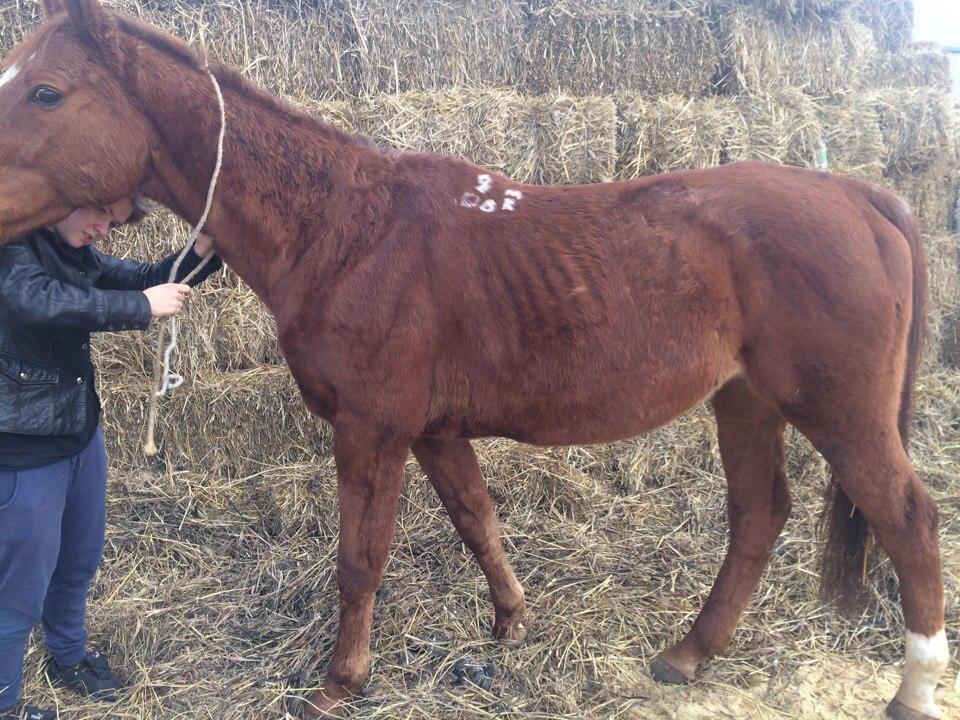
For the treatment of leptospirosis in horses, streptomycin and hyperimmune serum are mainly used. Specific antibodies to leptospira are the basis of serum.
Important! When using serum, it should be borne in mind that recovered animals may remain carriers of the infection.
Vaccine use
Horse breeders and farmers should attach great importance to preventive measures. The main focus is on vaccinating healthy animals.
Composition, release form and principle of action
The vaccine is produced in the form of a clear, colorless liquid (contains an inactivated strain of Leptospira). Single dose - 1-2 ml, contained in a hermetically sealed bottle. When injected intramuscularly, horses develop a stable immunity to leptospirosis.

Indications for use
It is recommended to vaccinate animals that are raised on dysfunctional farms (in relation to the likelihood of an outbreak) when grazing horses in foci of possible infection. The main goal of vaccination is preventive. Using the vaccine, it is possible to prevent the emergence and spread of infection, to reduce the likelihood of abortion.
Instructions for use
When injected intramuscularly, the vaccine is injected into the neck (upper third area). When using the product, take into account the age of the animal. The first vaccination for foals up to 6 weeks old is given in a volume of 1 ml, the next one is carried out six months later in the same volume. Older foals (age 6-12 months) are injected with 1 ml of serum, repeated injection is done after 6 months. For adult horses, the dose is increased to 2 ml, the subsequent inoculation is done a year later.
When starting the vaccination process, it should be borne in mind that immunity to leptospirosis in animals appears 2-3 weeks after the administration of the drug. Resistance to infection with the infection remains in foals for 6-8 months, and in adults - 12-15 months.
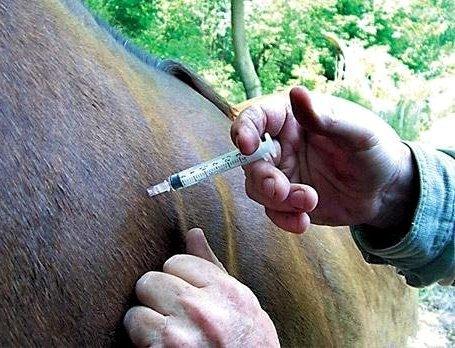
Important! Do not mix the drug with other drugs in the same syringe.
Contraindications and side effects
When using the vaccine, it must be borne in mind that the drug is harmless and does not have medicinal qualities. Sick or weakened horses should never be vaccinated. During the week, they also do not vaccinate animals that have taken drugs for helminths. Do not vaccinate mares in the last four weeks of pregnancy and the first 7 days after birth.
Sometimes swelling may appear at the injection site, which will naturally dissolve over time. In some individuals, manifestations of allergic reactions are possible. To quickly stop the development of allergies, it is recommended to always have calcium chloride or diphenhydramine on hand for the period of vaccination of animals.
Precautions
For storage of the drug, the appropriate conditions are provided: temperature - 2-15 ° С, container protected from sunlight. In the process of vaccination of animals, it is necessary to use personal protective equipment for people (gloves, gown). Certain requirements are also met:
- hands are thoroughly washed with soap after the end of the drug administration procedure;
- if a person gets the vaccine on the skin or mucous membranes, wash the liquid with a swab moistened with alcohol, wash the body parts with water;
- used syringes and vials are disposed of.
Do not use drugs that have been frozen, or if the expiration date is not marked on the vials. The vaccine that has expired or stored in containers with a violation of tightness, integrity should be disposed of.
Also, destroy the drug that remains unused within 25-30 minutes after opening (the vaccine is boiled for 15-20 minutes and disposed of). Great attention is paid to the prevention of diseases when keeping any animals. It is important not only to provide the correct housing and nutrition for horses and foals. It is necessary to vaccinate all healthy individuals in a timely manner.
